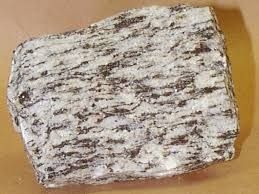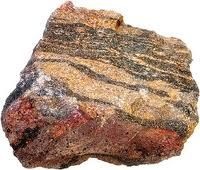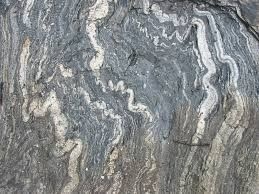METAMORPHIC ROCKS
Dynamic Metamorphism: It is associated with the zones of high to moderate strain such as Fault Zones
The textures of dynamic metamorphic zones are dependent on the met. environment where they were formed – the temperature and confining pressure determine the Deformation Mechanism. Within the depths less than 5 km, dynamic metamorphism is usually not produced because the enormous confining pressure is too low. Instead, a zone of breccia (a rock composed of broken fragments of various minerals or of rock cemented together with fine-grained matrix (e.g. ground-mass) or cataclasite (a cataclastic rock formed during faulting) is established with the pre-existing rock ground and broken into irregular fragments

Cataclasis: It is a process of fracturing, crushing or grinding i.e. reduction in size of the fragments of pre-existing rocks and then formation into angular fragments, the texture known as Cataclastic Texture; it mostly takes place in dynamic metamorphic zones Cataclastic
(5) Dynamo-thermal Metamorphism: It a form of regional metamorphism that acts on the rocks caught between the two converging plates and is caused by the pressure directed from the said plates which causes some of the rocks to rise and others to sink. The rocks which fall, experience further dynamo-thermal metamorphism, now caused by the heat provided by the earth's interior and the pressure by the overlying rocks
Re-crystallization Already mentioned
(ii) Neo-crystallization Already mentioned
(iii) Phase Change: Creating new minerals with the same chemical formula as that of the protolith; it involves the rearrangement of the atoms in the crystals of the protolith – thus changing the physical properties only

(iv) Pressure Solution: It is a metamorphic process that requires a rock (protolith) to be under strong pressure from one direction and in the presence of extremely hot water around the rock. During this process, minerals of the protolith dissolve, diffuse in the water and precipitate elsewhere. Hence there is change in chemical and mineral composition and constitution
Plastic Deformation: In plastic deformation, high pressure is applied to protolith which causes it to shear or bend, but not break. In order this to happen, temperature must be high enough that brittle fractures do not occur
(vi) Prograde and Retrograde Metamorphism: Prograde metamorphism involves the change of mineral assembling with the increase in temperature and pressure. These are solid state dehydration reactions, which involve the loss of volatile substances such as water or carbon dioxide Prograde metamorphism results in rock characteristics of having attained the maximum pressure and temperature. Such met. rocks do not undergo further change when they are brought to the surface
Retrograde metamorphism involves the reconstitution of a rock via revolatilisation under the decreasing temperature (and usually pressure), allowing the mineral assembly formed in prograde metamorphism revert to more stable formation at less extreme conditions

Texture of Metamorphic Rocks:
Slaty: Showing texture of Slate – texture of a rock like thin leaves or plates; it includes Slate and Phyllite (a green, grey or red metamorphic rock rich in mica derived from a shale)
Schistose: Showing the texture of Schist: texture of medium-grained to coarse-grained metamorphic rocks composed of laminated, often flaky parallel layers chiefly of micaceous minerals
Gneissose: Showing the texture of Gneiss: characterized by the texture of alternating darker and lighter coloured bands called Gneistic Bands
Granoblastic: Showing the texture of Granulite: texture of the grains visible to the naked eye, sutured boundaries and almost equidimensional grains
Hornfelsic: Showing the texture of Hornfels: massive, hard, splintery and banded texture
Rock Cleavage: Property of a met. rock to be split along certain directions yielding (more or less) parallel and smooth surfaces
Schistosity: Property of a met. rock showing the parallel bands
Foliation: Already mentioned
Grades of Metamorphism and Metamorphic Rocks:
(i) Low Grade: When the Index Minerals of a met. rock are formed at a temperature between 200 OC to 400 OC, e. g. laumonite and lawsonite
(ii) Medium Grade: When the Index Minerals of a met. rock are formed at a temperature between 400 OC to 650 OC, e. g. staurolite and cordierite
(iii) High Grade: When the Index Minerals of a met. rock are formed at a temperature greater than 650 OC, e. g. hypersthene
Metamorphic Facies: It is defined as a group of met. rocks which are formed under the closely related met. environments (as mentioned earlier), e.g. Green-Schist, Amphibolite, Granulite, Zeolite, Pyroxene-hornfels



